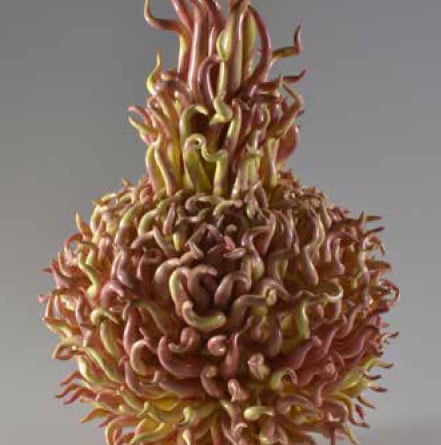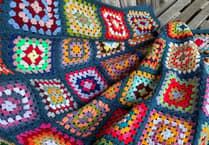The unseen world of plants has been re-imagined by the ceramic art of MA ceramics graduate Pat Small.
A passionate botanical painter and retired secondary art teacher, Pat had always had an urge to work with clay. Encouraged by family and emboldened by the “wonderful ceramics reputation” of the University for the Creative Arts (UCA), she took up ceramics at UCA’s Farnham campus to fulfil that need.
Influenced by Professor Rob Kesseler’s micro photography and glass artist Dale Chihuly, Pat was increasingly amazed at the beauty of a plant’s microscopic structure; its geometric, repetitive and symmetrical form. From infinitesimal seed heads to pollen walls and fungi, Pat reveals these microscopic structures in clay.
Some of her sculptures comprise many small hand-made components and Pat explained the process can be “super fiddly,” as well as “meditative and absorbing”. And, ever the perfectionist, the whole making process requires a great deal of patience.
Her favourite piece, White Medusa, took her three weeks to complete, not including the two-week drying period.
Pat said: “My process is to make the small components in large quantities, keeping them in order of size under plastic because porcelain dries quickly.”
While some of her ceramics, like Rhubarb and Custard, are inspired by actual seed heads, like the Herb Bennet, her Blue Pollen Wall sculpture is a mash-up of different images she found. And the colours used are mainly from her imagination.
She added: “Colour is important, and I mix my colours using stains on test tiles beforehand. Using these, I am confident the colour will be as planned.
“Glazing is another story as this can be unpredictable if it’s applied too thickly or too thinly. For a complicated piece that requires glazing, I will spray the glaze on to the structure.”
With comments like “wow”, “stunning” and “absolutely beautiful” on her Instagram page, Pat is excited to cast new elements and see what will emerge. She said: “The reaction to my sculptures has been very pleasing. The intricate range of shapes and colours draws viewers in to inspect the work more closely.”




